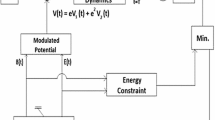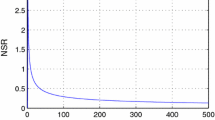Abstract
In most of the proposals for quantum computers, a common feature is that the quantum circuits are expected to be made of cascades of unitary transformations acting on the quantum states. Such unitary gates are normally assumed to belong to a given discrete set of transformations. However, arbitrary superposition of quantum states may be achieved by utilizing a fixed number of transformations, each depending on a parameter. A framework is proposed to dynamically express these parameters directly in terms of the control inputs entering into the continuous time forced Schrouml;dinger equation.
PACS: 03.67.Lx; 03.65.Fd; 02.30.Mv; 02.30.Xy
Similar content being viewed by others
REFERENCES
C. Altafini, J.Math. Phys. 43(5), 2051-2062 (2002).
C. Altafini, ''Parameter differentiation and quantum state decomposition for time varying Schrödinger equations.'' Preprint arXiv:quant-ph/0201034, 2002.
D. Cory, R. Laflamme, E. Knill, L. Viola, T. Havel, N. Boulant, G. Boutis, E. Fortunato, S. Lloyd, R. Martinez, C. Negrevergne, M. Pravia, Y. Shart, G. Teklemarian, Y. Weinstein, and Z. Zurek, Prog.Phys. 48, 875 (2000).
J. Craig, Introduction to Robotics 2nd ed. (Addison Wesley, Reading, MA, 1989).
D. D'Alessandro, ''Uniform finite generation of compact Lie groups and universal quantum gates.'' quant-ph/0111133, 2001.
D. Deutsch, A. Barenco, and A. Ekert, Proc. R. Soc. London, A 449, 669-677 (1995).
R. R. Ernst, G. Bodenhausen, and A. Wokaun, Principles of Magnetic Resonance in One and Two Dimensions (Oxford Science Publications, 1987).
R. Gilmore, Lie groups, Lie algebras, and Some of Their Applications (Wiley, New York, 1974).
S. Lloyd, Phys.Rev.Lett. 75, 346-349 (1995).
W. Magnus, Comm.Pure and App.Maths. VII, 649-673 (1954).
J. Marsden and T. Ratiu, Introduction to Mechanics and Symmetry, Vol. 17, 2nd ed. Texts in Applied Mathematics (Springer Verlag, 1999).
M. Mehring, High Resolution NMR in Solids (Springer Verlag, 1976).
P. Moan, J. Oteo, and J. Ros, J. Phys. A 32, 5133-5139 (1999).
F. Murnaghan, The Unitary and Rotation Groups (Spartan, Washington, DC, 1962).
K. Nemoto, Generalized coherent states for SU(n) systems. J. Phys. A: Mathematics and General, 33 3493-3505 (2000).
M. A. Nielsen and I. L. Chuang, Quantum Computation and Quantum Information (Cambridge Univ. Press, 2000).
A. M. Perelomov, Generalized Coherent States and Their Applications Texts and monographs in Physics (Springer Verlag, 1986).
V. Ramakrishna, K. L. Flores, H. Rabitz, and R. Ober, Phys. Rev. A 62(5), 3409 (2000).
M. Reck, A. Zeilinger, H. Bernstein, and P. Bertani, Phys. Rev. Lett. 73(1), 58-61 (1994).
S. G. Schirmer, In Proc.40th Conference on Decision and Control, Orlando, Florida (2001).
S. G. Schirmer, A. D. Greentree, V. Ramakrishna, and H. Rabitz, ''Quantum control using sequences of simple control pulses.'' Preprint quant-ph/0105155, 2001.
R. H. V. Ramakrishna, Phys. Rev. A 54, 1715-1716 (1996).
V. S. Varadarajan, Lie groups, Lie algebras and Their Representations (Springer Verlag, 1984).
N. Weaver, J. Math. Phys. 41(1/5), 240-243 and 3300 (2000).
J. Wei, J. Math. Phys. 4, 1337-1341 (1963).
J. Wei and E. Norman, Proc.of the Amer.Math. Soc. 15, 327-334 (1964).
W. Zhang, D. Feng, and R. Gilmore, Rev. of Modern Physics 62, 867-927 (1990).
Author information
Authors and Affiliations
Rights and permissions
About this article
Cite this article
Altafini, C. On the Generation of Sequential Unitary Gates from Continuous Time Schrödinger Equations Driven by External Fields. Quantum Information Processing 1, 207–224 (2002). https://doi.org/10.1023/A:1019825109040
Issue Date:
DOI: https://doi.org/10.1023/A:1019825109040




